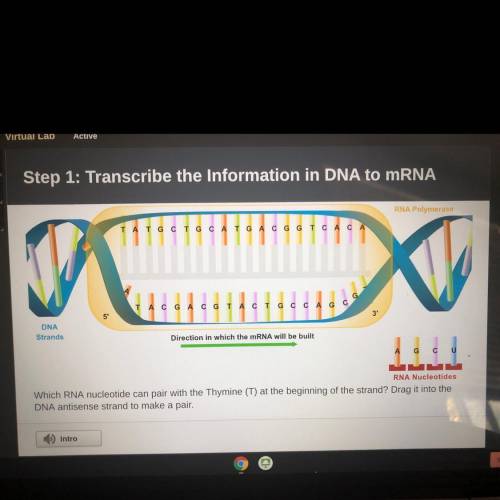RNA Polymerase
TATGCTGCATGA CGGT CACA
TAC G A C GTACT GCC AG
3'
DNA
Strands...

RNA Polymerase
TATGCTGCATGA CGGT CACA
TAC G A C GTACT GCC AG
3'
DNA
Strands
Direction in which the mRNA will be built
RNA Nucleotides
Which RNA nucleotide can pair with the Thymine (T) at the beginning of the strand? Drag it into the
DNA antisense strand to make a pair.


Answers: 2
Another question on Biology

Biology, 21.06.2019 17:20
What protects the lining of the stomach from acidic gastric juices?
Answers: 1

Biology, 22.06.2019 05:30
Hector is back from his morning run and is feeling light-headed because his energy is depleted which food item will provide him with a quick source of carbohydrates
Answers: 1

Biology, 22.06.2019 08:40
What best explains whether bromine (br) or neon (ne) is more likely to form a covalent bond? bromine forms covalent bonds because it has seven valence electrons, but neon has eight valence electrons and already fulfills the octet rule. bromine forms covalent bonds because it has many electron shells, but neon has only two electron shells and is tightly bound to its electrons. neon forms covalent bonds because it can share its valence electrons, but bromine has seven valence electrons and can gain only one more electron. neon forms covalent bonds because it has only two electron shells, but bromine has many electron shells and will lose electrons in order to fulfill the octet rule.
Answers: 3

Biology, 22.06.2019 09:10
Explain the cellular functions that occur when antibiotics attack a bacteria cell. a. antibiotics target the cell wall, cell membrane, and the processes of protein and nucleic acids production in bacteria to rupture the cell. b. antibiotics create dormant resistant endospores to preserve the genetic material and rupture the cell. c. antibiotics target the cell wall and form a bridge-like connection to form conjugation. d. antibiotics use binary fission to grow twice its size, replications its dna, and split into two cells.
Answers: 2
You know the right answer?
Questions

Mathematics, 28.06.2019 08:50

Mathematics, 28.06.2019 08:50









Computers and Technology, 28.06.2019 09:00


Mathematics, 28.06.2019 09:00









